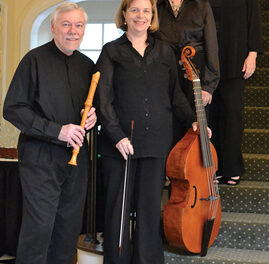It’s been my experience in the past three years that the universally lauded renovation of Duke University’s Baldwin Auditorium has made that venue itself at least part of the draw for people to attend concerts there. So, it was no surprise that a very large crowd showed up on an unseasonably warm February Sunday to hear a program named Duke Faculty Chamber Music Concert. At the risk of being annoyingly musically pedantic, this title is somewhat of a misnomer. The performers were not all faculty at Duke’s Department of Music and, generally, when you see the phrase “chamber music” you expect two or more players for each composition played.
There is a wealth of great chamber music of every conceivable combination featuring the classical guitar, so when I saw the name Randy Reed on the posters for this concert, my expectation was a chamber work paired with one or more of the immensely talented musicians at Duke. I was surprised to find instead that there would be a mini solo guitar recital to begin the program.
Heitor Villa-Lobos was/is considered the most influential Brazilian composer ever. His enormously prolific output includes a collection of solo guitar works (as well as a lovely guitar concerto) that has become a staple of nearly any guitarist who has put fingernail to nylon. Reed, part-time guitar instructor at Duke since 1994, chose a solo program of three of the five preludes and four of the twelve études. For the most part, Reed has a firm grasp and confident control of the technical aspects of playing, but at this level, that is, or certainly should be, a given. What was missing was attention to most of the details that give an inner life to musical performance and emotional rapport with the audience. Villa-Lobos is quite explicit in his dynamic changes, tempo alterations and articulation markings, yet there was little, if any, observance of those. There are too many examples to cite them all, but blithely racing through the lovely slow section of Prelude no. 3, marked “Molto adagio e (dolorido),” is a typical one. On the other hand, there were numerous examples of slowing down to accommodate technically demanding passages, where there are no indicators to do so. A kind of constant middle-of-the-road dynamic level denied us the rich palette of sounds available from the instrument. There is a lot of potential here, but only if there is a renewed dedication to making music come alive.
We then moved from the six strings of the guitar to the 47 strings of the harp as we heard two works by Maurice Ravel. Featured in both was harpist Laura Byrne, one of the most active performers on the instrument in the Triangle area. Joining her in the first piece was fellow Duke faculty member Elizabeth Linnartz, soprano, in Ravel’s Cinq Melodies Populaires Grecques, a set of five folk songs arranged by Carlos Salzedo. These are relatively brief and unrelated poems dealing with everything from nature to churches to young love. One could sense that Byrne actually read and understood the poems (not always the case with accompanists) as she tailored her playing to the text. Linnartz sang with lovely and simple grace that channeled the innocence of the young and idealistic. No warbling opera voice here – beautiful clear, straight tones. Although I’m not a fan of singers ostentatiously acting out the words, my one complaint is that she could have shown a little more emotion or facial recognition of the text.
Many French composers had a fascination with all things Spanish and Ravel’s Pièce en forme de Habanera is a perfect example of this. Joining Byrne was Susan Francher on soprano saxophone. This short work is a quietly, erotically pulsating Spanish rhythm (thankfully way shorter than Bolero) that Francher played with a lush and seductive tone. This little performance was an example of that famous showbiz adage: leave them wanting more.
The second half consisted entirely of a single work that many consider possibly the greatest chamber music work, regardless of instrumentation: the Trio for Violin, Horn and Piano by Johannes Brahms. The listed performers were Eric Pritchard, violin, Rachel Niketopoulos, horn, and R. Larry Todd, piano. This turned out to be not entirely correct as Rachel (as she introduced herself) came out to explain the differences between a modern horn and the valveless horns of Mozart and Beethoven’s time. But there was an unnamed man sitting with a horn on the stage. It turns out that that was Christopher Caudill. He and Rachel not only both play in the horn section of the North Carolina Symphony, but they are married. He (unaffiliated directly with Duke) would play the first two movements and she (part-time Duke faculty) would play the last two, including the use of a valveless horn in the Adagio third movement.
It began a bit tentatively as the horn and violin couldn’t quite agree on intonation and the piano’s tempi seemed to be challenging both. It almost felt like a part clicking into place as the trio reached a sublime emotional connection that is integral to this work. Despite some assertions otherwise, great music does not just play itself. The alluded-to third movement clearly demonstrated the difference in sound of the two types of horn as Rachel had to play chromatic notes using different positions of her hand within the bell.
It is always a joy to hear such a monumental work played by seasoned performers who understand and communicate the brilliance and profundity of Brahms. But I return to what I started out with: it seems that a concert that is supposed to showcase the performing faculty of Duke’s Department of Music should be much more inclusive and more creative in their programming.











